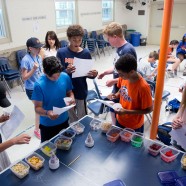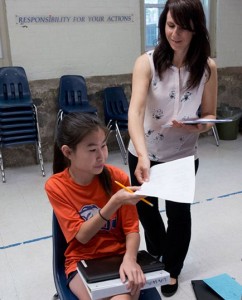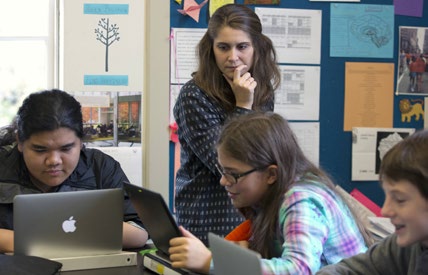
In the student lounge of Ware Hall one morning in late May, seventh graders were piecing together snack “necklaces” to represent what they’d learned about themselves. They’d just completed year one of the Middle School’s 360 program. A mini-Saltine cracker meant they knew their learning style, and could easily articulate it. Gummy candies and fruit loops in different flavors represented auditory, visual and tactile/kinesthetic learning. A Cheerio represented empathy, and a purple gummy ring was the sign of good time management. A Cheez-It indicated that the wearer would rather work on a project than write a paper. More than a dozen options were available for the choosing, one sign of the range of topics covered in 360, a class all seventh and eighth graders take, co-taught by counselor Nicci King and learning specialist Liz West.
After assembling their edible jewelry, students shared their stories.
“I learned that I need to manage my time, and I’ve gotten much better at that,” one girl offered. “I used to be really antsy and fidgety in class, but I learned that I’m a tactile/kinesthetic learner, so when I do a hands-on physical project, I focus much better.”
“I think I’ve become a more reliable friend,” a boy said. “I know what not to do while studying, and what was distracting me before,” another student piped in.
“I’ve become more aware of what’s going on around me, and how it affects others, not just me.”
 The 360 program addresses students’ academic, social and emotional growth—considering how a teenager develops as a student, friend and community member—during years in which their brains are frequently rewiring. Over the past decade, 360 has evolved from an elective life-skills class into today’s comprehensive format, a program Middle School Principal Will Crissman says “gets better and better every year.”
The 360 program addresses students’ academic, social and emotional growth—considering how a teenager develops as a student, friend and community member—during years in which their brains are frequently rewiring. Over the past decade, 360 has evolved from an elective life-skills class into today’s comprehensive format, a program Middle School Principal Will Crissman says “gets better and better every year.”
Liz and Nicci alternate the sections they teach on a two-week schedule. They use two separate classrooms and two different curricula, but the subject areas often overlap.
Liz, the learning specialist, helps the students understand their dominant learning styles, whether they’re auditory, tactile/kinesthetic or visual. She works with them on time management and study skills. Nicci, the Middle School counselor, teaches students communication skills and self-advocacy, just as students are expected to take ownership of their success, preparing for high school life. Nicci also works with students on mindfulness and stress management, and shares tools for navigating the social and emotional obstacles of teenage life.
“We want boys and girls to see themselves as more than just students,” Nicci says. “We want them to see their strengths—what they’re excellent at—and also those areas where they might need to advocate for themselves, because they may struggle in certain things.”
Liz adds that she wants students to consider their struggles as calls for improvement, rather than weaknesses. Success stories from 360 often begin when a student realizes, “I need help, and I’m going to seek it.”
For Brendan, time management was difficult before 360. Through the program, he learned that his dominant learning style is kinesthetic, or hands-on, so when he has to build something for one class and write a paper for another, he now knows to budget more time to work on the paper. Brendan says he intends to put his 360 knowledge to the test in the Upper School this fall, using what he’s learned about how sleep, nutrition and hydration can support academic performance.
“I don’t think I can say that I’m completely prepared, because the Upper School is a major step up in the amount of work that we’ll have, but I feel much more prepared than if I hadn’t taken 360,” Brendan says. “I’m more comfortable going to my teachers now if I have questions, because I understand that it’s useful, and they want us to succeed.”
The Middle School is a perfect environment for this kind of affective education, Liz explains. While students are going through the constant and major changes of their teen years and taking on the responsibilities of managing their own class schedules, becoming aware of how they learn and communicate is critical. As schoolwork becomes more difficult, the tight-knit group of educators are on hand to help them improve.
 Kids start to push away from their parents and tackle challenges on their own—something that can be tough for parents. “Kids are going to become less communicative with their parents, and that’s normal,” Liz says. “Parents can always reach out to us and talk. The best thing parents can do as our partners is to let kids know that it’s okay to fail, because failing leads to opportunity.”
Kids start to push away from their parents and tackle challenges on their own—something that can be tough for parents. “Kids are going to become less communicative with their parents, and that’s normal,” Liz says. “Parents can always reach out to us and talk. The best thing parents can do as our partners is to let kids know that it’s okay to fail, because failing leads to opportunity.”
Nicci adds, “And it builds resilience. Life is not perfect. Students are going to struggle and be challenged, so we want that to happen here and now when it’s in a pretty controlled setting. That way we can say, ‘There it is. It happened. You survived it. And now, what do we know?’”
Self-awareness serves students for life, explains Will. The program gives students the tools to advocate for themselves socially as well as academically. The goal is that students leave the Middle School knowing themselves very well.
Kavi, who completed eighth grade in June, said seeing his peers do the self-evaluation in 360 prompted him to think of himself as an individual. Knowing his learning style helped him study more efficiently, but it also created an understanding that everyone has different strengths and struggles.
“It takes a burden off people’s shoulders to see others finding out who they are and how they learn, and just becoming more comfortable with themselves. Now I know that if I am having trouble, I need to ask myself if there is a different way I can approach the problem,” Kavi says. “I think that’s one of the great things about the Middle School as a whole: Self-advocacy is something that all of our teachers emphasize. Our teachers push us to talk to them and understand ourselves as learners, and 360 gives us the guidelines for talking to them about what we need as students.”
by Marisa Donelan



